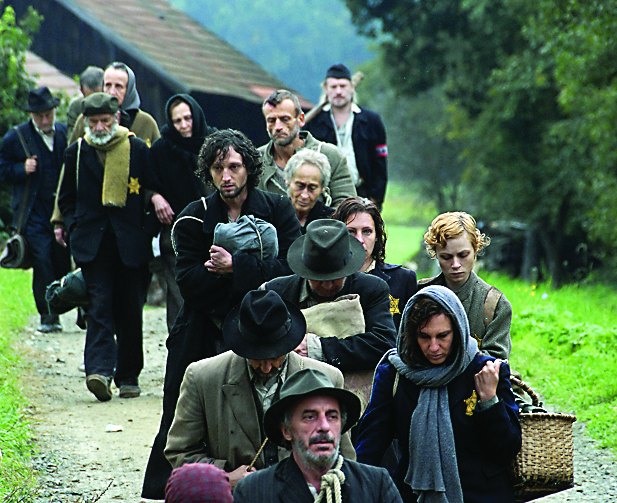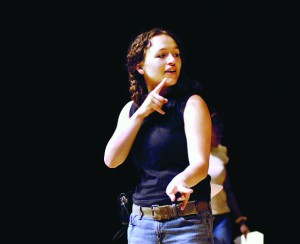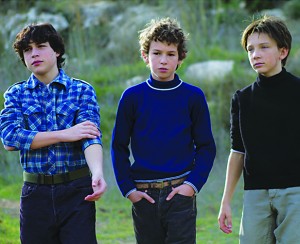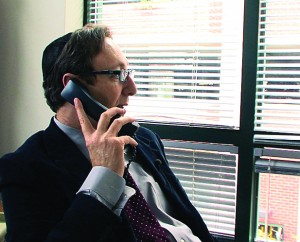Fuse Movie Review: The BJFF Continues — More Critical Responses
More comments on the films in this year’s Boston Jewish Film Festival, including Standing Silent, a powerful documentary on child abuse in the orthodox Jewish community and an effective adaptation of David Grossman’s novel The Book of Intimate Grammar.
By Joann Green Breuer.
“Neighbors Near and Far” is this year’s cut line for the 23rd Boston Jewish Film Festival (BJFF). Congratulations are certainly due for its longevity and general quality, along with sympathy for its effort to come up with a new cut line, even if it makes more politically correct sense than it does semantic sense.
This is an other installment in my overview of a selection of the BJFF fare. The festival ends on November 15th. My comments will be brusque, partly because the BJFF no longer supplies a program with attributions to artistic contributors to the films: casts, designers, editors, etc. Financial contributors to the festival, however, are clearly listed.
Part One of BJFF reviews.
Part Two of BJFF reviews.
In Another Lifetime
In Another Lifetime centers on one of the tortured trudges Hungarian Jews took from their homes to Mauthausen concentration camp. The journey is long; the war has been long; the soldiers need rest. The displaced Jews die or are murdered indiscriminately, shock muted by resignation. The stopping place is an Austrian village. The temporary prison for the Jews is a barn.They are exhausted, discouraged, ill, and hungry, but among them is a spark of life: music. In ragged costume, neck ruff lace dangling, clothed in shreds of decorations, real and metaphoric, a former star opera singer demands of the weak and weary a profound trust in the transformational power of art.
By serendipitous, fictional chance, the farmers in whose barn they are barred are also musicians, who have also lost what mattered most to them. Will Gentile and Jew find common solace? Within his commandeered room, the Nazi soldier leans back to the sounds of a borrowed gramophone. He can produce no music of his own. Within the hay-strewn barn, prisoners (tenor, pianist, violinist) and amateurs persuade each other to perform.
In the town’s shabby tavern, Nazi sympathizers bend their backs, elbows, and minds to beer and resentment. The Austrian farmers, in whose barn the Jewish prisoners collapse, now bitter and silent, have, in better times, made their own melodies. Will Jew and Gentile find actual harmony? Will art achieve what ammunition destroys? It is 1944. We know there is hope, if not for art, at least for armistice.
Director Elisabeth Scharang comes close to letting wish fulfillment overtake the film completely. Throughout In Another Lifetime there is much scrubbing of actual agony, given the gentle technicolors, too many coincidences, and even a predictable round-up of cliché characters. There is sorrowful sex, broken song, a virgin kiss, anger released, submerged, and mutated, the fierce Frau confronting her forbidding Herr.
Yes, we have seen it all before. Nonetheless, the honesty of the Scharang’s conclusion, in casting, camera work, and event, is worthy of moving respect.
Yes, art can transform life, but can art save it?
Yellow Peppers
In two episodes, maybe even within the first moments of the first episode, I became an addict of Yellow Peppers, last year’s (recently renewed) marvelous, Israeli TV drama. Advertised as a teledrama about autism, it is so much more. Autism is but one catalyst fueling these family dynamics. Each member of this credible clan carries his/her own weight, as character and as actor. Keren Margalit, creator of the series, was one of the original developers of In Treatment, a highly lauded program that I have not seen. Judging by Yellow Peppers, however, I would claim that Margalit is not the Aaron Sorkin of Israel, Sorkin is the Margalit of the USA.
The series begins conventionally. A son newly returned to the family farm allows the audience to be introduced to the community even as he is re-acquainted with it. Here, with utmost scripting skill, awkward moments prick curiosity and emotions are withheld with sustained politesse, while a chorus of comic relief begins to broaden what might have been a narrow perspective surprisingly, gracefully, grandly. The potential here is evident. Step by naturally theatrical step, that potential is realized.
For those old enough, Yellow Peppers is reminiscent of All in the Family, and for the less superannuated, Modern Family, without the laugh track. The difference is Yellow Peppers’ are lines with punch, not punch lines.
Questions weave the poignant, uneasy plots: what is genius?; how does what one loves turn the endearing into the incredibly annoying?; at what point does valuable personal advice become intrusively painful?; how much is the past an appropriate measure of the present? The bottom line question is what is the way to help and heal?
Speaking mutual Hebrew, the family members misunderstand each other. Guest workers, speaking in unsubtitled Thai, gradually discarding their anonymity, are wise comic foils, witnesses to deepening conflicts. The latter Greek-like, quartet chorus demonstrates the power of communication beyond words. Let’s hope that when Yellow Peppers is adapted into an English TV series, its tender and abusive humane language is not lost in translation.
Deaf Jam
As its “Centerpiece Film” the BJFF has chosen Deaf Jam, a documentary about the making of poems in American Sign Language. Judy Lieff demonstrates her chops as a dance videographer. She also proves she is a loving fan of her leading poets: the Deaf, Israeli-American, energetic teen Aneta Brodski and her writing partner, Tahani, the hearing, Palestinian-American, hijab-wearing teen. (I capitalize Deaf because that is the identifying orthography of those who communicate preferentially in ASL.)
The film is a celebration of ASL. This language of motion-sans-sound is equated with a particular, unique culture. Culture is identified by its artistic expression. Poetry, as claimed by teacher and teens, is the manifestation of the ultimate in linguistic art. Instinct, intelligence, and inspiration are essential and matter, but practice and training make the result awesome.
These girls are awesome indeed. In Lieff’s visualizations, words fly from fingers with rhythmic and relevant animation. The lively letters bounce, tumble, roll in the air above as well as around the silently eloquent poet. When Aneta and Tahani create joint poetry, their message is a politically correct call for peace, but it is made with such innocently intense charm and physical partnership that one yearns to believe in it and, for the moment, does.
However, I do proffer a few caveats, concerning both the content and structure of the film. Sometimes the ASL message goes too far. Yes, there is unpleasant and unnecessary competition between oralists and signers, the two rarely overlapping in the Deaf/deaf communities. Still, equating Alexander Graham Bell (believer in and instigator of the disastrous policy of oral-only education for the Deaf) with Hitler is hyperbolic. Cochlear implants are a valid choice for some.
In terms of cinematic comprehension, the three modes of communication on screen, though technically adept, can be confusing or distracting. One wants to focus on the signing, even if one is not competent in ASL. Subtitles draw the eye downwards, while those flying words draw the eye up. Meanwhile, frequent voice-overs give spoken English a verbal track to follow, which does not naturally match the more elaborate, semantic extension of signed poetry. An ASL poem is far more iconic as well as more physically extended in time and space. (For the record, I have directed bilingual plays, ASL/English, and remain a perpetual ASL tyro enthusiast.) ASL poetry is to mundane conversation the equivalent of opera to chitchat. Attention boggles given all that has to be made sense of at once.
Also, the film is erratically structured, intermittently and unpredictably shifting attention from the poets to the culture. There are gaps in time and training that leave important (and answerable) questions hanging. No documentary can cover everything, but I bet there are enough scenes on the cutting room floor for an objective editor to make this culturally revelatory story soar higher and more steadily.
Intimate Grammar
Israeli writer David Grossman’s The Book of Intimate Grammar has been, for the most part, faithfully adapted by Nir Bergman into the film Intimate Grammar. Black and white footage of happy, Israeli pioneers, dancing their bliss during ha’Atzmaot (Independence Day) celebrations, serve as the ironic touchstone for the story’s penetrating portraits of Israeli citizens 15 years, half a generation later. Memories of pre-1948 are unexpressed and repressed. Yet they shape the lives of the film’s damaged and damaging family.
Bergman centers on the younger child, a pre-pubescent boy, too small for his liking, too insightful for his own good, and too powerless to alter his world. Relationships among family and friends are desperate and inappropriate. Daughter is overweight and under-appreciated, but she extends whatever comfort is possible to the little brother she envies and adores. Mother is a rage of inexplicable rules and irrationality. Next door, a young, beauteous pianist plays seductive melodies and removes whatever apartment walls she can between her and her married neighbor.
Outside the working class apartment, a tree is warped with worm holes and the scum that they exude. Try as the family’s father might to seal the holes with poisonous paste, it is to no avail. Covering up is not possible. The metaphor is obvious, but nonetheless pictorially apt. The issue remains: if there is no cure, is there escape? Little brother plies his little Houdini schemes, again an obvious symbol, but in this case a touching one.
There is touch of schematic feel to the lento, legato pacing of the film. We are given ample time to wish all well and to recognize that wishing does not make it so. From time to time, however, the naturalism of circumstance is belied by cinematic indulgence. An occasional actor-ish moment, a fancy trick of a lens angle, takes one out of the situation and plunks the viewer into a (too) self-conscious drama. We are accidentally permitted the escape that is ultimately, realistically, and tragically denied Intimate Grammar‘s pained brethren.
Standing Silent
The honesty of a documentary is measured by the transparency of its rules of selectivity as well as the voices through whom its subject is recounted. Scott M. Rosenfelt, experienced producer of popular features (Home Alone, Mystic Pizza) puts his newly exercised directing talent to a difficult topic and, although somewhat repetitively, explores a sordid situation with respect, compassion, fairness, and visual verve.
Rosenfelt’s sad and brave Standing Silent centers on Phil Jacobs, past editor of the Baltimore Jewish Times. His voice is intensely personal and honest. He speaks to the person behind the camera, ultimately us, as snow falls relentlessly in the night beyond his office window.
The symbolism is fortuitous. Jacobs has stories to tell and the courage and skill to write them in the local, Jewish newspaper. His slow, sweet manner of expression makes the stories he tells trustworthy and affecting. Jacobs and others are victims/survivors of child sexual abuse.
Rosenfelt is clearly at Jacobs’s side and heart, even as Jacobs is shunned and threatened by the closed and defensive, orthodox community in which this brave, scarred newsman grew up and, for a time, continues to live. Some of the perpetrators are rabbis. We have seen much the same in the Roman Catholic clergy abuse scandals: denial, depression, disbelief, and defense. A moral standard is a mockery. This is not only sexual abuse; it is spiritual abuse. Those entrusted to teach and do right, those to whom we are told to turn, those who are bound to protect, fail their child charges and their religious charge.
Horrific as it is, this, significantly, is not the complete story of Standing Silent. Rosenfelt’s artistic skills and social conscience are exhibited with rare, necessary, and complex clarity. His mastery of techniques, strengthened by his intellect and editing skills, present contrasting and enlightening insights.
Mixed in with the visual techniques of split screen, shifting/moving frame sizes, and double exposures are the to-be-expected scenes of mundane neighborhood activity: a woman shawl-wrapped in shame, close-ups on individual faces, piercing, pained eyes, fist clutching palms. Rosenfelt pans among ritual, Jewish objects, pages of Torah, Jewish rites and rituals. With elegant pathos, he lets other rabbis, worthy of the role, speak to the issue and to his camera. Particularly eloquent is Rabbi Abram Twersky, all bones and beard, frail in body but firm in conscience.
But it is Rosenfelt’s exploration of the essence of Judaism that brings this film to righteous levels. I only wish the title offered a clue to the far less obvious ethical quandary exposed here, one that can tongue-tie the Talmudic-ly inclined.
Paralleling the double exposures of the film is the double challenge of the Jewish ethic: not to stand silent in the face of wrong (hence the title of the film) and, in contrast, lashon hara, not to speak evil of someone (presumably if one is unsure of truth). One need only recall the Fells Acre disaster. Standing Silent delineates this difficult, moral juxtaposition, stretching beneath and beyond personal agony. It is this quandary, speak or remain silent, that Judaism requires believers to face up to. To Rosenfelt’s credit, despite the buffeting pull of the contradictory emotional flood tides, his camera does.
Following the showing of the film, the BJFF held a panel with Sarah L. Rubin, Rosenfelt, a social worker, and Michael Paulson, the leading Boston Globe reporter in the newspaper’s coverage of the Catholic clergy scandal. They are all well-meaning, but, as the subsequent discussion indicated, perhaps a movie theater is not the optimum site for opening this sensitive can of bane. Their suggestions of contacting organizations JSafe and The Shofar Coalition would more usefully have been provided in printed handouts.
Tagged: Boston Jewish Film Festival, Deaf Jam, In Another Lifetime, Intimate Grammar, Standing Silent




